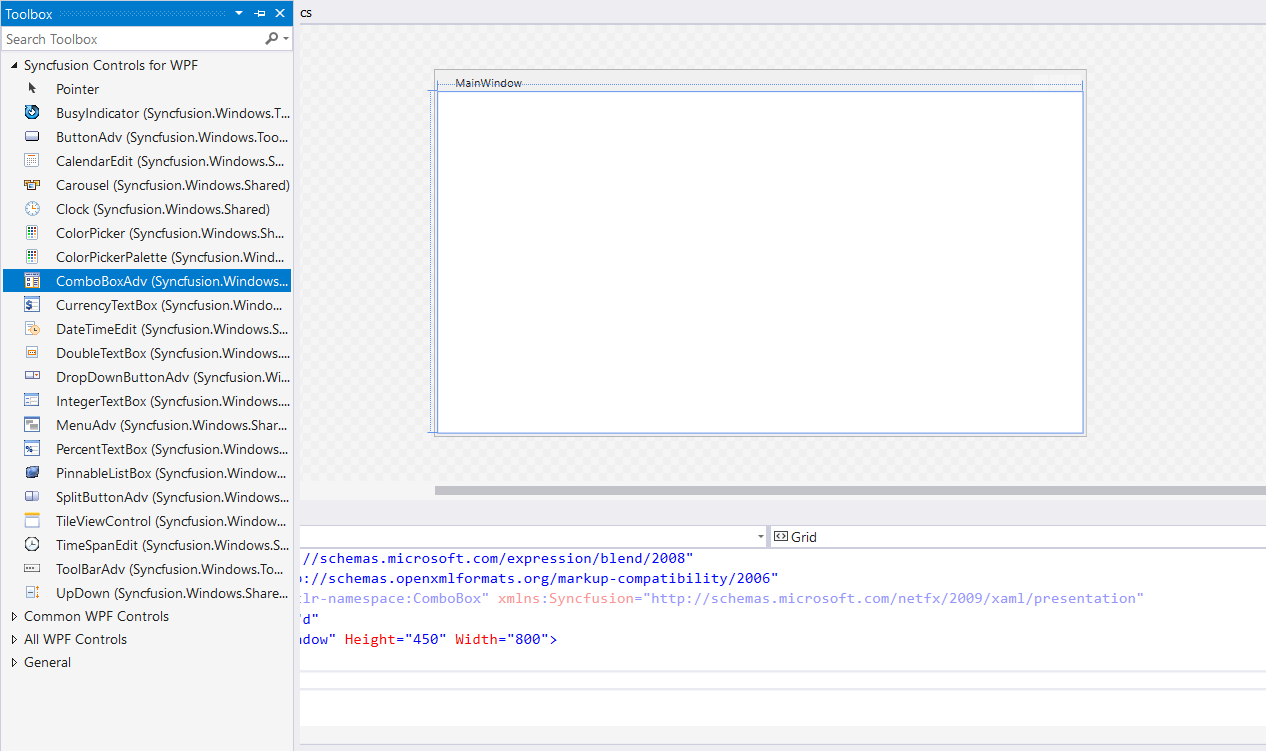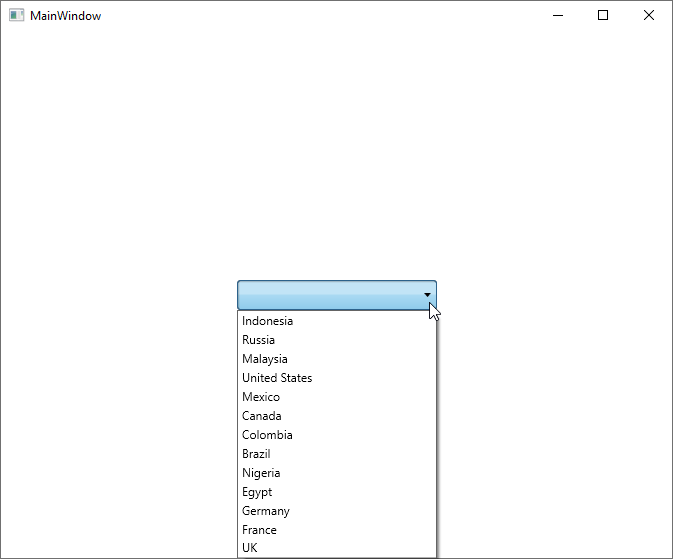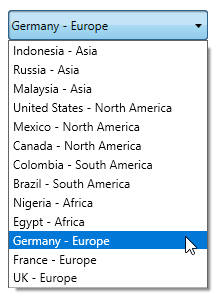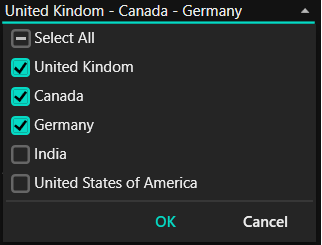Getting Started with WPF ComboBox (ComboBoxAdv)
16 Oct 202316 minutes to read
This section provides a quick overview for working with the ComboBox (ComboBoxAdv).
NOTE
Assembly deployment
Refer to the control dependencies section to get the list of assemblies or NuGet package that needs to be added as a reference to use the ComboBoxAdv control in any application.
You can find more details about installing the NuGet package in a WPF application in the following link:
How to install nuget packages
Creating Application with ComboBoxAdv control
In this walk through, user will create a WPF application that contains ComboBox control.
- Creating project
- Adding control via designer
- Adding control manually in XAML
- Adding control manually in C#
- Creating Data Model for sample application
- Binding to Data
Creating project
Below section provides detailed information to create new project in Visual Studio to display ComboBoxAdv.
Adding control via designer
The ComboBoxAdv control can be added to the application by dragging it from Toolbox and dropping it in designer. The required assemblies will be added automatically.

Adding control manually in XAML
In order to add ComboBoxAdv control manually in XAML, do the below steps,
-
Add the below required assembly references to the project,
- Syncfusion.Shared.WPF
-
Import Syncfusion WPF schema http://schemas.syncfusion.com/wpf in XAML page or Syncfusion.Windows.Tools.Controls namespace.
-
Declare ComboBoxAdv in XAML page.
<Window xmlns="http://schemas.microsoft.com/winfx/2006/xaml/presentation" xmlns:x="http://schemas.microsoft.com/winfx/2006/xaml" xmlns:d="http://schemas.microsoft.com/expression/blend/2008" xmlns:mc="http://schemas.openxmlformats.org/markup-compatibility/2006" xmlns:local="clr-namespace:GettingStartedComboBox" xmlns:syncfusion="http://schemas.syncfusion.com/wpf" x:Class="GettingStartedComboBox.MainWindow" mc:Ignorable="d" Title="MainWindow" Height="450" Width="800"> <Grid> <syncfusion:ComboBoxAdv Height="30" Width="150"/> </Grid> </Window>
Adding control manually in C#
In order to add ComboBoxAdv control manually in C#, do the below steps,
-
Add the below required assembly references to the project,
- Syncfusion.Shared.WPF
-
Import ComboBoxAdv namespace Syncfusion.Windows.Tools.Controls.
-
Create ComboBoxAdv control instance and add it to the page.
using System.Windows; using Syncfusion.Windows.Tools.Controls; namespace ComboBox { /// <summary> /// Interaction logic for MainWindow.xaml /// </summary> public partial class MainWindow : Window { public MainWindow() { InitializeComponent(); ComboBoxAdv comboBoxAdv = new ComboBoxAdv(); this.Content = comboBoxAdv; comboBoxAdv.Height = 30; comboBoxAdv.Width = 150; comboBoxAdv.DefaultText = "choose Items"; } } }
Adding items in ComboBoxAdv
Items can be added in the ComboBoxAdv control by following ways.
- Adding items by ComboBoxItemAdv.
- Adding items by DataBinding.
Add items using ComboBoxItemAdv
The items in ComboBoxAdv can be created by using ComboBoxItemAdv in XAML or C# code.
<syncfusion:ComboBoxAdv Height="30" Width="200"
HorizontalAlignment="Center"
VerticalAlignment="Center" >
<syncfusion:ComboBoxItemAdv Content="Denmark" />
<syncfusion:ComboBoxItemAdv Content="New Zealand" />
<syncfusion:ComboBoxItemAdv Content="Canada" />
<syncfusion:ComboBoxItemAdv Content="Russia" />
<syncfusion:ComboBoxItemAdv Content="Japan" />
</syncfusion:ComboBoxAdv>public MainWindow()
{
InitializeComponent();
ComboBoxAdv comboBoxAdv = new ComboBoxAdv() { Height=30,Width= 200
,HorizontalAlignment= HorizontalAlignment.Center, VerticalAlignment = VerticalAlignment.Center };
ComboBoxItemAdv item1 = new ComboBoxItemAdv() { Content = "Denmark" };
ComboBoxItemAdv item2 = new ComboBoxItemAdv() { Content = "New Zealand" };
ComboBoxItemAdv item3 = new ComboBoxItemAdv() { Content = "Canada" };
ComboBoxItemAdv item4 = new ComboBoxItemAdv() { Content = "Russia" };
ComboBoxItemAdv item5 = new ComboBoxItemAdv() { Content = "Japan" };
comboBoxAdv.Items.Add(item1);
comboBoxAdv.Items.Add(item2);
comboBoxAdv.Items.Add(item3);
comboBoxAdv.Items.Add(item4);
comboBoxAdv.Items.Add(item5);
this.Content = comboBoxAdv;
}Adding items by DataBinding
The items in ComboBoxAdv can be added by data binding by following below procedure.
Creating Model and ViewModel data for DataBinding
-
Create data object class named PopulationInfo and declare properties as shown below,
public class PopulationInfo { private string continent; private double population; private string country; private double growth; public string Continent { get { return continent; } set { continent = value; } } public string Country { get { return country; } set { country = value; } } public double Growth { get { return growth; } set { growth = value; } } public double Population { get { return population; } set { population = value; } } } -
Create a ViewModel class with several data objects in constructor.
public class PopulationViewModel { public PopulationViewModel() { this.PopulationDetails = new ObservableCollection<PopulationInfo>(); PopulationDetails.Add(new PopulationInfo() { Continent = "Asia", Country = "Indonesia", Growth = 3, Population = 237641326 }); PopulationDetails.Add(new PopulationInfo() { Continent = "Asia", Country = "Russia", Growth = 2, Population = 152518015 }); PopulationDetails.Add(new PopulationInfo() { Continent = "Asia", Country = "Malaysia", Growth = 1, Population = 29672000 }); PopulationDetails.Add(new PopulationInfo() { Continent = "North America", Country = "United States", Growth = 4, Population = 315645000 }); PopulationDetails.Add(new PopulationInfo() { Continent = "North America", Country = "Mexico", Growth = 2, Population = 112336538 }); PopulationDetails.Add(new PopulationInfo() { Continent = "North America", Country = "Canada", Growth = 1, Population = 35056064 }); PopulationDetails.Add(new PopulationInfo() { Continent = "South America", Country = "Colombia", Growth = 1, Population = 47000000 }); PopulationDetails.Add(new PopulationInfo() { Continent = "South America", Country = "Brazil", Growth = 3, Population = 193946886 }); PopulationDetails.Add(new PopulationInfo() { Continent = "Africa", Country = "Nigeria", Growth = 2, Population = 170901000 }); PopulationDetails.Add(new PopulationInfo() { Continent = "Africa", Country = "Egypt", Growth = 1, Population = 83661000 }); PopulationDetails.Add(new PopulationInfo() { Continent = "Europe", Country = "Germany", Growth = 1, Population = 81993000 }); PopulationDetails.Add(new PopulationInfo() { Continent = "Europe", Country = "France", Growth = 1, Population = 65605000 }); PopulationDetails.Add(new PopulationInfo() { Continent = "Europe", Country = "UK", Growth = 1, Population = 63181775 }); } public ObservableCollection<PopulationInfo> PopulationDetails { get; set; } }
Binding to Data
To bind the ComboBoxAdv to data, bind the collection created in previous step to ItemsSource property in XAML by setting PopulationViewModel as DataContext.
<Window
xmlns="http://schemas.microsoft.com/winfx/2006/xaml/presentation"
xmlns:x="http://schemas.microsoft.com/winfx/2006/xaml"
xmlns:d="http://schemas.microsoft.com/expression/blend/2008"
xmlns:mc="http://schemas.openxmlformats.org/markup-compatibility/2006"
xmlns:local="clr-namespace:GettingStartedComboBox"
xmlns:syncfusion="http://schemas.syncfusion.com/wpf" x:Class="GettingStartedComboBox.MainWindow"
mc:Ignorable="d"
Title="MainWindow" Height="450" Width="800">
<Grid>
<Grid.DataContext>
<local:PopulationViewModel/>
</Grid.DataContext>
<syncfusion:ComboBoxAdv x:Name="comboBoxAdv" Height="30" Width="200" ItemsSource="{Binding PopulationDetails}"/>
</Grid>
</Window>namespace ComboBox
{
public partial class MainWindow : Window
{
public MainWindow()
{
InitializeComponent();
this.DataContext = new PopulationViewModel();
}
}
}Binding display member
DisplayMemberPath denotes the path to a value on the data object for visual presentation of item to be displayed in combobox drop down list and displays the selected item in ComboBoxAdv.
<Grid>
<Grid.DataContext>
<local:PopulationViewModel/>
</Grid.DataContext>
<syncfusion:ComboBoxAdv x:Name="comboBoxAdv" Height="30" Width="200" ItemsSource="{Binding PopulationDetails}" DisplayMemberPath="Country"/>
</Grid>// Initialize the display member path to comboboxadv.
this.comboBoxAdv.DisplayMemberPath = "Country";
NOTE
Defining ItemTemplate
You can customize the visualization of data object using the ItemTemplate.
<Grid>
<Grid.DataContext>
<local:PopulationViewModel/>
</Grid.DataContext>
<syncfusion:ComboBoxAdv x:Name="comboBoxAdv" Height="30" Width="200" ItemsSource="{Binding PopulationDetails}">
<syncfusion:ComboBoxAdv.ItemTemplate>
<DataTemplate>
<StackPanel Orientation="Horizontal">
<TextBlock Text="{Binding Country}"/>
<TextBlock Text=" - "/>
<TextBlock Text="{Binding Continent}"/>
</StackPanel>
</DataTemplate>
</syncfusion:ComboBoxAdv.ItemTemplate>
</syncfusion:ComboBoxAdv>
</Grid>
Selection
ComboBoxAdv supports single and multiple selection of items. By default the selection of items in ComboBoxAdv is single selection. In order to select multiple items in ComboBoxAdv, enable the AllowMultiSelect property and select those multiple items from the drop down list.

You can select the item or get the index of the selected item by using the SelectedIndex property. When an item is selected in ComboBoxAdv, you can get their information using SelectedItem or SelectedValue property. For multiple selected items, use SelectedItems property. The selection of the items can be handled using SelectionChanged event.
Editing
IsEditable property helps to edit the text in ComboBoxAdv.

Theme
ComboBoxAdv supports various built-in themes. Refer to the below links to apply themes for the ComboBoxAdv,

See Also
How to filter dropdown items in WPF editable ComboBoxAdv?
How to define maximum number of items to be shown in combobox dropdown?